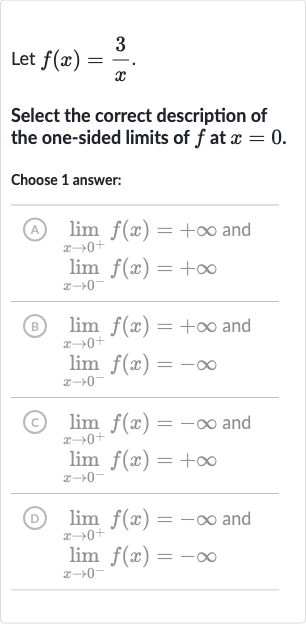Full solution
Q. Let .Select the correct description of the one-sided limits of at .Choose answer:(A) and (B) and (C) and (D) and
- Analyze behavior of as approaches : Analyze the behavior of the function as approaches from the positive side ().As gets closer to from the positive side, the value of becomes larger and larger because the denominator of the fraction is getting smaller. This means that the function is approaching positive infinity.
- Calculate limit of as approaches : Calculate the limit of as approaches from the positive side.
- Analyze behavior of as approaches : Analyze the behavior of the function as approaches from the negative side ().As gets closer to from the negative side, the value of becomes more negative and larger in magnitude because the denominator of the fraction is getting smaller and is negative. This means that the function is approaching negative infinity.
- Calculate limit of as approaches : Calculate the limit of as approaches from the negative side.
- Combine results from Step and Step : Combine the results from Step and Step to answer the question prompt.The one-sided limits of the function as approaches are: and
More problems from Compare linear and exponential growth
QuestionGet tutor help
QuestionGet tutor help
QuestionGet tutor help
QuestionGet tutor help
QuestionGet tutor help
QuestionGet tutor help
QuestionGet tutor help

